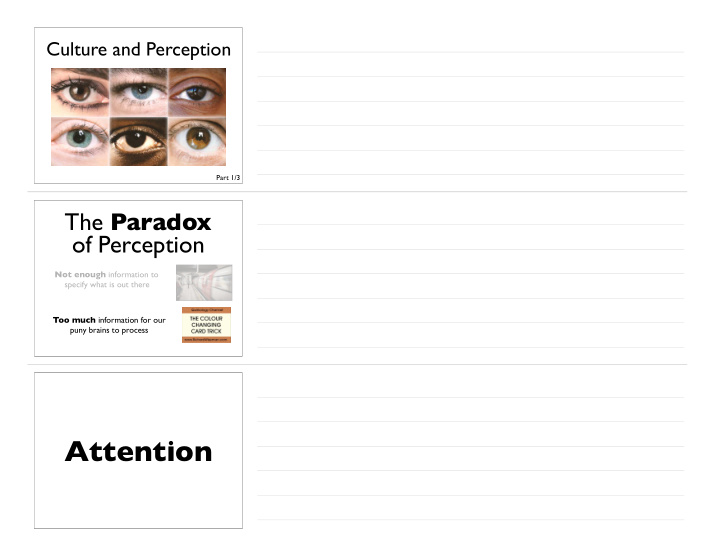



Culture and Perception Part 1/3 The Paradox of Perception Not enough information to specify what is out there Too much information for our puny brains to process Attention
Attention … is the taking possession by the mind, in clear and vivid form, of one out of what seem several simultaneously possible objects or trains of thought William James (1842-1910) Attention Limited Capacity you can’t pay attention to everything “Selective” you can pay attention to some things at the expense of others
Voluntary (and usually effortful) Involuntary (and usually effort less ) Find the red “o” x x x x x x x o x x x x x x x Find the red “o” x o x x o x x x x x o x o x o
Overt (attend by moving your eyes) Covert (attend by moving your mind )
Attention W estern E ducated I ndustrialized R ich D emocratic
A (Silly?) Stereotype “Westerners” (incl. USA, W. Europe) analytic, object-focused, individualist. “the trees” “Easterners” (incl. Japan, Korea, China) holistic, context-focused, collectivist. “the forest” * this is an exclusionary and reductive way of dividing up populations; please bear with me… American Parents Relative emphasis on nouns “Is that a ball? Yes, that’s a ball!” Chinese Parents Relative emphasis on verbs & events “Can you give it to me? Now I give it to you!”
A maybe the blue fish wanted to be independent B maybe the other fish were being mean American (relatively speaking) maybe the blue fish wanted to be independent Chinese (relatively speaking) maybe the other fish were being mean
“Focal” Changes “Contextual” Changes
Time to Detect Changes 11 Seconds Taken American 10.5 East Asian 10 9.5 9 8.5 Focal Changes Contextual Changes (Masuda & Nisbett, 2006) Questions + Themes How much of our culture has its basis in perception ? How much of our perception has its basis in culture ? Culture and Perception Up next: Part 2/3
Culture and Perception Part 2/3 Questions + Themes How much of our culture has its basis in perception ? How much of our perception has its basis in culture ? Facial Attractiveness Aesthetic Preferences
Facial Attractiveness Aesthetic Preferences Fusiform Face Area Babies like faces… …even at 9 mins old! (Goren et al., 1975)
Most Attractive? + = averaged faces together to find common negative traits; averages were attractive! Francis Galton (1822-1911)
How attractive? (Rate on a scale of 1-5) 3.5 How Attractive? (1-5) 3.3 3.1 2.9 2.7 2.5 2 4 8 16 32 # of faces averaged together (Langlois & Roggman, 1990)
Hadza: Hunter-gatherer society with no exposure to “Western” norms of beauty “Koinophilia” liking ‘common’ features perhaps to minimize harmful mutations
How “distinct” is this face? (distinctness = opposite of averageness) More distinct faces: More illnesses! (Cold, measles, etc. …) (Rhodes et al., 2001) Facial Attractiveness Aesthetic Preferences Facial Attractiveness Aesthetic Preferences
Culture and Perception Up next: Part 3/3 Culture and Perception Part 3/3 Facial Attractiveness Aesthetic Preferences
Facial Attractiveness Aesthetic Preferences
Most people like blue Most people dislike dark yellow (“vomit yellow”) Saturated colors are liked more than muted colors
Ecological Valence Theory we like the colors we like because they are the colors of the things we like Blue things tend Dark yellow things to be nice tend to be nasty (or at least not bad) Democrats like blue, Republicans like red… …and even more so on Election Day!
Preference for Red 45 Democrats 36 Preference Republicans 27 18 9 0 Normally Election Day Berkeley students like Gold, Stanford students like Red …but only if they like their school! Facial Attractiveness Aesthetic Preferences
Culture can change… …how we pay attention Culture can change… …what looks beautiful Culture can change… … how we see in the first place??
W estern E ducated I ndustrialized R ich D emocratic Muller-Lyer Illusion
Muller-Lyer Illusion Muller-Lyer Illusion Muller-Lyer Illusion
Muller-Lyer Illusion
“Because elements such as carpentered corners are products of particular cultural evolutionary trajectories, and were not part of most environments for most of human history, the Muller-Lyer illusion is a kind of culturally evolved by-product” Cataracts : “Easy” to fix — just pay ~ $3,000 !
Visual illusions only hours after seeing for the first time! “Carpentry” can’t be to blame… …“culture” can only do so much! Culture and Perception
Recommend
More recommend